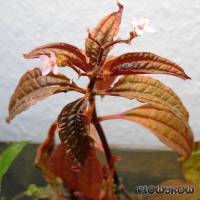



The genus Aciotis comprises around 14 species. It belongs to the large family of Melastomataceae (melastomes), which consists mainly of tropical shrubs and small trees, amongst them beautiful flowering plants like Medinilla and Tibouchina. There are some aquatic and marsh plants among the herbaceous representatives, mainly in the genus Acisanthera. Aciotis acuminifolia is the first aquarium plant from this family. It was first imported into the US in 2005 and was brought into the hobby as "Sao Francisco Irecienu". In the US, it is still readily available from fellow hobbyists. In Europe it still seems to be more or less unknown.
This plant was probably collected on Rio Sao Francisco in eastern Brazil, however, the exact location is in the dark. At first it was thought to be an Acisanthera species, but in 2009, a DNA analysis was done, which, among others, led to the identification as species of the genus Aciotis - hence the name Aciotis sp. Recently (May 2011) it was identified as Aciotis acuminifolia (Mart. ex DC.) Triana, according to information of Cavan Allen (aquaticplantcentral.com). This species is rather widely distributed in the South-American tropics.
Aciotis acuminifolia grows strictly upright and has four-edged stems with crosswise opposite leaves with parallel leaf veins typical for the Melastomataceae family. Its submersed leaves are coloured in green, yellow or reddish hues, with a red underside. A higher light intensity causes the reddish colour to intensify. The margin of younger leaves curves slightly upwards, however, this curve decreases the older the leaves get.
A. acuminifolia easily grows out of the water, and emersed cultivation is not difficult as long as air humidity is high. The emersed sprouts do not differ significantly from the submersed ones, however, the leaf margin is more pronouncedly serrate, and the leaves are of a more intensive red under good lighting. The complex inflorescence (cymes or dichasia) has only a low number of around 7 to 8 mm large pale pink flowers with four petals, which develop into even smaller, roundish green fruit full of reddish seeds fine like dust.
When cultivated submersed in an aquarium, this plant needs soft water and an ample nutrient supply. Moderate to high light and a good supply of CO2 are strongly recommended. If its demands are not met, the leaves will grow distinctly narrower and might even curl up. A lack of light or a shaded location will lead to stunted growth, or a growth stop altogether, leaf loss and maybe even to the total decomposition of the plant. Under good conditions, however, it has a moderate growth rate and throws a lot of lateral shoots, which can be cut off and re-planted in the substrate for propagation purposes. As in other stem plants, cutting off the upper part of the stem will lead to a stronger development of lateral shoots on the remaining lower part. The substrate does not seem to play an important role; in any case, A. acuminifolia develops a strong, widely spreading root system after some time.
<a href="https://www.flowgrow.de/db/aquaticplants/aciotis-acuminifolia" target="_blank"><img alt="Aciotis acuminifolia" title="Aciotis acuminifolia" src="https://www.flowgrow.de/db/widget/aquaticplants/aciotis-acuminifolia" /></a>
[url=https://www.flowgrow.de/db/aquaticplants/aciotis-acuminifolia][img]https://www.flowgrow.de/db/widget/aquaticplants/aciotis-acuminifolia[/img][/url]
[widget=aquaticplants/aciotis-acuminifolia]Aciotis acuminifolia[/widget]